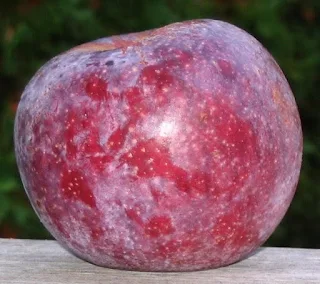 |
| Blue Pearmain Apple. Image from Adam's Apples blog |
Whoever named it Will power was deluded. It should have been called WON'T power. This is a time of year when I pray for more Won't power.
This is the time of year when I am looking through seed catalogs and reviewing reviews of various fruit bearing plants. Being fairly proficient at grafting, I can turn a $4 stick into a fruiting tree rather than having to spend $46 per "store-bought" tree.
Disclosure: I could live the rest of my life with just Liberty and GoldRush apple and Korean Giant Asian pear and be very satisfied.
Intellectually I know that most "heirloom" apple and pear varieties are obsolete for very good reasons. The selection pressure was not very rigorous. It was not uncommon for a pioneer to have an orchard with two dozen trees and he might name the two "best" seedlings...typically after his wife and his oldest daughter.
Modern releases might be the best 1-in-100,000 or 1-in-500,000 rather than the pioneers best 1-in-12. The modern breeder is screening for resistance to a half dozen diseases, looking at how long it takes to come into bearing, productivity, cosmetic appeal, picking window, storage ability, ease of culture and so on. The pioneer simply observed "Yeah, this one tastes pretty good".
That said, hundreds-of-thousands of seedlings were grown over the last two hundred years and some of them are pretty good and if you are willing to tolerate their quirks they can offer some unique taste experiences.
And therein lies my vulnerability with regards to seduction.
Blue Pearmain: The flesh is dense, yellow, coarse, and just in case I didn't say, dense. More on that later. The flavor is mild and sweet, but not simple, with hints of pear, melon, caramel, vanilla, and corn. There is the merest suggestion of something like grapefruit peel in the undertow. (Adams Apples description)
Reinette Zabergau: This tree is large, vigorous, cold hardy (to zone 4), and a heavy cropper, but nonetheless reliably annual. It is a triploid and two diploid pollenizers will need to be present for full fertility, but the tree has no other difficulties. It is mildly susceptible to scab but otherwise disease resistant.
One of the largest of the russets, this apple is bronze patched and streaked over a green background. It is a dense apple, but crunchy and aromatic. The flavor when harvested is intense and sweet-sharp, but it mellows in storage, developing a balanced sweetness that has the rich nuttiness we expect from a good russet. It will store well through the winter and it has found favor with some American cider makers for its aromatic qualities. (Cummins Nursery description)
Black Oxford: Winter. Unknown parentage. Paris, Oxford County, Maine, about 1790. This outstanding apple, a favorite long ago around much of Maine, has made a huge comeback.
Medium-sized round fruit, deep purple with a blackish bloom. From a distance you might think you’d discovered a huge plum tree. Excellent pies, superb late cider. Leave the skins on for a delightful pink sauce. Best eating late December to March, but we’ve eaten them in July and they were still quite firm and tasty. They get sweeter and sweeter as the months go by. Good cooking until early summer.
Some insect and disease resistance. Unusual light pink blooms early to midseason. (Fedco Seed description)
Sweet Sixteen: Sweet Sixteen is a popular apple for very cold northern regions. It ripens in early fall, just ahead of Honeycrisp™. It is crisp and juicy with an exotic yellow flesh and a very sweet, unusual sugar cane or spicy cherry candy flavor. The fruit stores for 5 to 8 weeks. It is a good all purpose apple. (Grandpa's Orchard description)
Opalescence: Fall. Unknown parentage. George M. Hudson intro, Shultz, Barry County, MI, 1890s. Originally called Hudson’s Pride of Michigan but eventually sold as Opalescent by Dayton Star Nurseries, Xenia, OH, 1899.
Highly flavored dessert apple, well known among collectors. Very large brilliant deep red white-dotted fruit. Crisp, sweet, tart, juicy—but most of all supremely flavorful. Also considered a good cooking apple. Keeps till mid-late winter. Would be an excellent apple for the small commercial orchard farm stand or the CSA.
Likely at its best from Massachusetts north. Vigorous medium-sized productive tree. (Fedco Seed description)
No comments:
Post a Comment
Readers who are willing to comment make this a better blog. Civil dialog is a valuable thing.